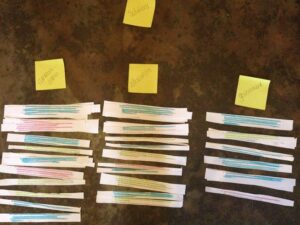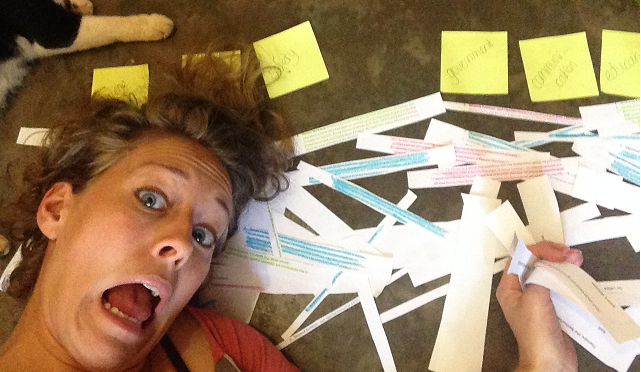You’ve collected a crazy load of information during your in-depth interviews. Great. But what’s next? From your research supervisor or boss you are expected to do something with that data. But how to get from such a data overload to a good conclusion? Here’s how to do your qualitative data analysis in four easy steps.
I can imagine you look up to doing analysis, you expect it to be boring and difficult. Where to start? How to narrow down this Mount Everest of info?! You don’t know where to start.
Data-analysis means “Eureka!” moments
 Well, here’s this. Analysis can be very interesting and it can give you those typical “Eureka!!” moments you never thought you would have. Often I hear researchers say: “I did lots of interviews but I think nothing interesting will come out”. The thing is, you vagely remember -sort of- all your interviews, but your brains have not made enough connections between all that information yet to draw conclusions. Data must be put together in tables, figures and maps and the like, to be able to compare it and see new things.
Well, here’s this. Analysis can be very interesting and it can give you those typical “Eureka!!” moments you never thought you would have. Often I hear researchers say: “I did lots of interviews but I think nothing interesting will come out”. The thing is, you vagely remember -sort of- all your interviews, but your brains have not made enough connections between all that information yet to draw conclusions. Data must be put together in tables, figures and maps and the like, to be able to compare it and see new things.
Thematic Content Analysis
One of the interesting ways to do qualitative analysis, especially in social science, is thematic content analysis. Out of the many supercomplex descriptions of how to conduct such analysis, I finally found an easy to go guideline that I would like to share with you. It is merely one of the ways to go, but for each analysis counts this: always keep your research objective and research questions in the back of your mind! This is going to help you in making the right decisions and keeping focus.
Before you start
First of all, you need to make a decision of whether or not to (fully) transcribe your interviews or not. That is: are you going to write down e-ve-ry word that your voice recorder captured, or are you just going to make summaries? Transcribing will quadruple the quality of your analysis, but sometimes there is just not enough time to do all the writing as it can take up to -in the worst cases- six hours to transcribe just one hour of interviewing. The alternative is to make summaries and only write down the important quotes about the themes of your research. Discuss with your supervisor what would be best for you.
In your interviewing phase, make sure you document all your transcripts or summaries under labels, put for example the date and place of the interview, give each participant a code in which you –but only you can recognize who that person was and to which stakeholder-group he/she belongs.
Step 1. Get familiar with your data
Listen to your recordings, read notes and transcripts or summaries again. Try to do that all in one day so that it is fresh in your head. Make summaries per interviewed respondent or per topic and don’t forget to add demographic data such as age, gender, marital status and other relevant factors.
Step 2. Identify codes and themes
Look for regularities in your data. Divide transcripts into small segments and ask yourself the question at each segment: what is this segment about? Those are going to be your themes. Going through your whole transcript, the list of created themes is your first set of codes. From there, see if there are overlapping themes that you can put together under a new theme.
From there, check whether this set of codes captures what is going on and develop the final list that you can use to code the rest of your data.
Step 3. Coding your data
With your developed coding scheme, you can now identify the rest of your data and put all useful information into this coding scheme. Important to tell here that -as no interview is the same- new codes may arise, others may dissapear and others may merge together. Keep moving your segments and adapting your coding scheme until it all fits. To ease the matter a bit, put segments about the same matter on the same pile, and -if it fits your research purpose- you can do some importance ranking by simply counting the amount of segments per subject.
Step 4. Organize your codes and themes
Here’s where it all comes together. Cutting and pasting! You can interpret this as literally as cutting out data extracts and putting them together under each code that you wrote on a post it. Now you are creating a live table, so make sure you have enough space on the table, you might even want to use a big piece of empty floor. Use different colours to be able to recognize which extract came from which interview.
 Now it comes to looking carefully to your table. Do you see certain trends in your data? Which respondents (with which characteristics) tend to give which anwers? And more importantly: what does that mean? Don’t forget to ask yourself this last question, because that is what gives your conclusion that extra value!
Now it comes to looking carefully to your table. Do you see certain trends in your data? Which respondents (with which characteristics) tend to give which anwers? And more importantly: what does that mean? Don’t forget to ask yourself this last question, because that is what gives your conclusion that extra value!
From here, you can further clarify by for example drawing mind maps of your findings, making new tables about trends over time, histograms, venn diagrams et cetera. This goes beyond the thematic content analysis, which brings you to other forms of analysis.
Wanna know more?

Green and Thorogood describe this method very clearly and give good examples in their book ‘Qualitative Methods for Health Research’ (3rd edition). They dig deeper into the matter by for example describing how to conduct open coding and axial coding, differences between emic and etic levels, deductive and inductive analysis et cetera. They also describe more forms of analysis, in case you want to dig a little deeper.

